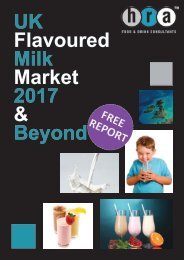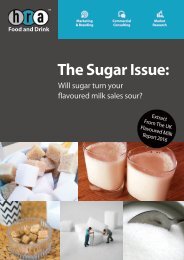FREE-UK-Flavoured-Milk-Report-2016-2017
The backdrop to the UK flavoured milk market is one of relentless change. The removal of the EU milk quotas, the transition to a Western-type diet by emerging economies, the UK sugar debate and the booming sports nutrition industry are all aspects of change that create both challenges and opportunities for the UK flavoured milk market. HRA Food and Drink Marketing has developed this report as a map to guide industry stakeholders. Although volume growth in 2014 was slightly lower than in previous years, the flavoured milk market still has plenty of room for product innovation and development. Overall, we expect the UK flavoured milk market to continue to grow over the medium term, but not without improving its nutritional profile. The sugar debate reached new heights when, in October 2015, Public Health England released a document suggesting Government intervention in the form of a sugar tax (levy). As a consequence, product reformulation has become a priority for all serious players in the market.
The backdrop to the UK flavoured milk market is one of relentless change. The removal of the EU milk quotas, the transition to a Western-type diet by emerging economies, the UK sugar debate and the booming sports nutrition industry are all aspects of change that create both challenges and
opportunities for the UK flavoured milk market.
HRA Food and Drink Marketing has developed this report as a map to guide industry stakeholders. Although volume growth in 2014 was slightly lower than in previous years, the flavoured milk market still has plenty of room for product innovation and development.
Overall, we expect the UK flavoured milk market to continue to grow over the medium term, but not without improving its nutritional profile. The sugar debate reached new heights when, in October 2015, Public Health England released a document suggesting Government intervention in the form of a sugar tax (levy). As a consequence, product reformulation has become a priority for all serious players in the market.
You also want an ePaper? Increase the reach of your titles
YUMPU automatically turns print PDFs into web optimized ePapers that Google loves.
<strong>UK</strong>#FLAVOURED#MILK#<strong>2016</strong>217#<br />
#<br />
Key Demographic Segments: 60+<br />
The reasoning for aggregating core consumers in this demographic<br />
segment is that both segments (60-74 and 75 & over) share sufficient<br />
characteristics to be considered similarly.<br />
Figure 3-8: Projected populations at mid-years by age: 60 years of age<br />
and over<br />
•#<br />
•#<br />
•#<br />
•#<br />
•#<br />
•#<br />
•#<br />
It is also important to remember that consumers in this target<br />
demographic are traditionally not typical flavoured milk consumers.<br />
Their purchasing power is typically high, making them a particular group<br />
of interest for high-protein and functional flavoured milk brands which are<br />
priced at a premium.<br />
Both segments of the population are at an age where preoccupation with<br />
their health surfaces as a priority. Bone density, sarcopenia and<br />
malabsorption of macronutrients are particular health concerns for this<br />
group.<br />
We identify this demographic as a particular opportunity because,<br />
besides its projected growth, specific nutritional needs of consumers in<br />
this segment (i.e. carbohydrates, fats, protein and calcium) can be met<br />
through the development of specific flavoured milk products.<br />
This consumer segment is not currently effectively targeted by flavoured<br />
milk brands. Although protein is clearly important to these consumers,<br />
brands should recognise they need to target this group in a different way.<br />
Older consumers typically want convenience and this is a potential issue<br />
for flavoured milk brands. Buying large flavoured milk packs is heavy and<br />
frequently buying smaller ready-to-drink packs is also often not of great<br />
appeal to older consumers who are less mobile. Powders are therefore<br />
the obvious way of targeting these consumers, or longer shelf life<br />
propositions into smaller bottles or cartons.<br />
Consumers in this segment can be reluctant to change their dietary<br />
habits. Therefore, any products aiming to target this segment will need to<br />
easily fit into their current routines rather than require any significant<br />
# 40#<br />
All rights reserved, ©Teepee#Ltd,#t/a#HRA#Food#&#Drink:#<strong>2016</strong>#<br />
to#<strong>2017</strong>#







